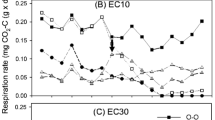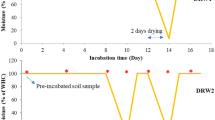Abstract
Aims
There are few studies on the interactive effect of salinity and sodicity in soils exposed to drying and wetting cycles. We conducted a study to assess the impact of multiple drying and wetting on microbial respiration, dissolved organic carbon and microbial biomass in saline and saline-sodic soils.
Methods
Different levels of salinity (EC1:5 1.0 or 2.5) and sodicity (SAR < 3 or 20) were induced by adding NaCl and CaCl2 to a non-saline/non-sodic soil. Finely ground wheat straw residue was added at 20 g kg−1 as substrate to stimulate microbial activity. The constant moist (CM) treatment was kept at optimum moisture content for the length of the experiment. The drying and rewetting (DW) treatments consisted of 1 to 3 DW cycles; each DW cycle consisted of 1 week drying after which they were rewet to optimum moisture and then maintained moist for 1 week.
Results
Drying reduced respiration more strongly at EC2.5 than with EC1.0. Rewetting of dry soils produced a flush in respiration which was greatest in the soils without salt addition and smallest at high salinity (EC2.5) suggesting better substrate utilisation by microbes in soils without added salts. After three DW events, cumulative respiration was significantly increased by DW compared to CM, being 24% higher at EC1.0 and 16% higher at EC2.5 indicating that high respiration rates after rewetting may compensate for the low respiration rates during the dry phase. The respiration rate per unit MBC was lower at EC2.5 than at EC1.0. Further, the size of the flush in respiration upon rewetting decreased with each ensuing DW cycle being 50–70% lower in the third DW cycle than the first.
Conclusions
Both salinity and sodicity alter the effect of drying and rewetting on soil carbon dynamics compared to non-saline soils.





Similar content being viewed by others
References
Anderson JM, Ingram JSL (1993) Tropical soil biology and fertility. CAB International, Wallingford
Austin AT, Yahdjian L, Stark JM, Belnap J, Porporato A, Norton U, Ravetta DA, Schaeffer SM (2004) Water pulses and biogeochemical cycles in arid and semiarid ecosystems. Oecologia 141(2):221–235
Backstrom M, Karlsson S, Backman L, Folkeson L, Lind B (2004) Mobilisation of heavy metals by deicing salts in a roadside environment. Water Res 38(3):720–732
Birch HF (1958) The effect of soil drying on humus decomposition and nitrogen availability. Plant Soil 10:9–31
Blake GR (1965) Bulk density. In: Black CA, Evans DD, Ensminger LE, White JL, Clark FE (eds) Methods of soil analysis. Part 1. Physical and mineralogical properties. American Society of Agronomy, Madison, pp 374–390
Blodau C, Basiliko N, Moore TR (2004) Carbon turnover in peatland mesocosms exposed to different water table levels. Biogeochemistry 67(3):331–351
Bouyoucos G (1936) Directions for making mechanical analyses of soils by the hydrometer method. Soil Sci 42(3):225–230
Brady NC, Weil RR (2002) The nature and properties of soils. Pearson Education Ltd, New Jersey
Butterly CR, Bünemann EK, McNeill AM, Baldock JA, Marschner P (2009) Carbon pulses but not phosphorus pulses are related to decreases in microbial biomass during repeated drying and rewetting of soils. Soil Biol Biochem 41(7):1406–1416
Chin YP, Aiken GR, Danielsen KM (1997) Binding of pyrene to aquatic and commercial humic substances: the role of molecular weight and aromaticity. Environ Sci Tech 31:1630–1635
Chowdhury N, Yan N, Islam MN, Marschner P (2011) The extent of drying influences the flush of respiration after rewetting in non-saline and saline soils. Soil Biol Biochem. Accepted for publication
Christ MJ, David MB (1996) Temperature and moisture effects on the production of dissolved organic carbon in a Spodosol. Soil Biol Biochem 28(9):1191–1199
Denef K, Six J, Bossuyt H, Frey SD, Elliott ET, Merckx R, Paustian K (2001) Influence of dry–wet cycles on the interrelationship between aggregate, particulate organic matter, and microbial community dynamics. Soil Biol Biochem 33(12–13):1599–1611
Fierer N, Schimel JP (2003) A proposed mechanism for the pulse in carbon dioxide production commonly observed following the rapid rewetting of a dry soil. Soil Sci Soc Am J 67(3):798–805
Fierer N, Schimel JP, Holden PA (2003) Influence of drying-rewetting frequency on soil bacterial community structure. Microb Ecol 45(1):63–71
Franzluebbers K, Weaver RW, Juo ASR, Franzluebbers AJ (1994) Carbon and nitrogen mineralization from cowpea plants part decomposing in moist and in repeatedly dried and wetted soil. Soil Biol Biochem 26(10):1379–1387
Hagemann M (2011) Molecular biology of cyanobacterial salt acclimation. FEMS Microbiol Rev 35(1):87–123
Halverson LJ, Jones TM, Firestone MK (2000) Release of intracellular solutes by four soil bacteria exposed to dilution stress. Soil Sci Soc Am J 64(5):1630–1637
Harris RF (1980) Effect of water potential on microbial growth and activity. Special Edition #9. In: Parr JF, Gardner WR (eds) Water potential relations in soil microbiology. Soil Science Society of America, Madison, pp 23–95
Jager G, Bruins EH (1975) Effect of repeated drying at different temperatures on soil organic-matter decomposition and characteristics, and on soil microflora. Soil Biol Biochem 7(2):153–159
Kalbitz K, Solinger S, Park JH, Michalzik B, Matzner E (2000) Controls on the dynamics of dissolved organic matter in soils: a review. Soil Sci 165(4):277–304
Keren R (2000) Salinity. In: Sumner ME (ed) Handbook of soil science. CRC Press, Boca Raton, pp 3–25
Khan KS, Gattinger A, Buegger F, Schloter M, Joergensen RG (2008) Micobial use of organic amendments in saline soils monitored by changes in the 13C/12C ratio. Soil Biol Biochem 40(5):1217–1224
Kieft TL, Soroker E, Firestone MK (1987) Microbial biomass response to a rapid increase in water potential when dry soil is wetted. Soil Biol Biochem 19(2):119–126
Kuiters AT, Mulder W (1993) Water-soluble organic-matter in forest soils.2. Interference with plant cation uptake. Plant Soil 152(2):225–235
Laura RD (1976) Effects of alkali salts on carbon and nitrogen mineralization of organic matter in soil. Plant Soil 44:587–596
Lundquist EJ, Scow KM, Jackson LE, Uesugi SL, Johnson CR (1999) Rapid response of soil microbial communities from conventional, low input, and organic farming systems to a wet/dry cycle. Soil Biol Biochem 31(12):1661–1675
Martinez-Beltran J, Manzur CL (2005) Overview of salinity problems in the world and FAO strategies to address the problem: Proceedings of the international salinity forum. Riverside, California, April 2005, pp 311–313
Meehl GA, Stocker TF, Collins WD et al (eds) (2007) Global Climate projections. In: Climate change 2007: The Physical Science Basis. Contribution of Working Group I to the Fourth Assessment Report of the Intergovernmental panel on Climate change. Cambridge University press, Cambridge, UK, pp 747–845
Mikha MM, Rice CW, Milliken GA (2005) Carbon and nitrogen mineralization as affected by drying and wetting cycles. Soil Biol Biochem 37(2):339–347
Miller AE, Schimel JP, Meixner T, Sickman JO, Melack JM (2005) Episodic rewetting enhances carbon and nitrogen release from chaparral soils. Soil Biol Biochem 37(12):2195–2204
Nelson PN, Ladd JN, Oades JM (1996) Decomposition of C-14-labelled plant material in a salt-affected soil. Soil Biol Biochem 28(4–5):433–441
Norrstrom AC, Bergstedt E (2001) The impact of road de-icing salts (NaCl) on colloid dispersion and base cation pools in roadside soils. Water Air Soil Pollut 127(1–4):281–299
Pathak H, Rao DLN (1998) Carbon and nitrogen mineralization from added organic matter in saline and alkali soils. Soil Biol Biochem 30(6):695–702
Peinemann N, Guggenberger G, Zech W (2005) Soil organic matter and its lignin component in surface horizons of salt-affected soils of the Argentinian Pampa. Catena 60(2):113–128
Prechtel A, Alewell C, Michalzik B, Matzner E (2000) Different effect of drying on the fluxes of dissolved organic carbon and nitrogen from a Norway spruce forest floor. J Plant Nutr Soil Sci 163(5):517–521
Prieme A, Christensen S (2001) Natural perturbations, drying-wetting and freezing-thawing cycles, and the emission of nitrous oxide, carbon dioxide and methane from farmed organic soils. Soil Biol Biochem 33(15):2083–2091
Pulleman M, Tietema A (1999) Microbial C and N transformations during drying and rewetting of coniferous forest floor material. Soil Biol Biochem 31(2):275–285
Qadir M, Schubert S (2002) Degradation processes and nutrient constraints in sodic soils. Land Degrad Dev 13:275–294
Qualls RG, Haines BL (1991) Geochemistry of dissolved organic nutrients in water percolating through a forest ecosystem. Soil Sci Soc Am J 55(4):1112–1123
Rayment G, Higginson F (1992) Australian laboratory handbook of soil and water chemical methods. Inkata Press, Sydney
Rengasamy P (2006) World salinization with emphasis on Australia. J Exp Bot 57(5):1017–1023
Richards LA (1954) Diagnosis and improvement of saline and alkali soils. Soil Sci 78(2):154
Rietz DN, Haynes RJ (2003) Effects of irrigation-induced salinity and sodicity on soil microbial activity. Soil Biol Biochem 35(6):845–854
US Salinity Laboratory Staff (1954) Diagnosis and improvement of saline and alkali soils, vol No. 60. USDA Handbook, US Government Printing Office, Washington DC
Schimel JP, Balser TC, Wallenstein M (2007) Microbial stress response physiology and its implications for ecosystem functions. Ecology 88:1386–1394
Shainberg I, Letey J (1984) Response of soils to sodic and saline conditions. Hilgardia 52(2):1–57
Sommers LE, Gilmour CM, Wildung RE, Beck SM (1981) The effect of water potential on decomposition process in soil. In: Parr JE, Gardner WR, Elliot LF (eds) Water potential relation in soil microbiology. Soil Science Society of America, Madison
Stark JM, Firestone MK (1995) Mechanisms for soil-moisture effects on activity of nitrifying bacteria. Appl Environ Microbiol 61(1):218–221
Sumner ME (1993) Sodic soils—new perspectives. Aust J Soil Res 31(6):683–750
Tripathi S, Kumari S, Chakraborty A, Gupta A, Chakrabarti K, Bandyapadhyay BK (2006) Microbial biomass and its activities in salt-affected coastal soils. Biol Fertil Soils 42(3):273–277
Vance ED, Brookes PC, Jenkinson DS (1987) An extraction method for measuring soil microbial biomass-C. Soil Biol Biochem 19(6):703–707
Voroney RP (2007) The soil habitat. Soil microbiology, ecology and biochemistry. Elsevier, Oxford
Walkley A, Black IA (1934) An examination of the Degtjareff method for determining soil organic matter, and a proposed modification of the chromic acid titration method. Soil Sci 37(1):29–38
Wong VNL, Dalal RC, Greene RSB (2008) Salinity and sodicity effects on respiration and microbial biomass of soil. Biol Fertil Soils 44:943–953
Wu J, Brookes PC (2005) The proportional mineralisation of microbial biomass and organic matter caused by air-drying and rewetting of a grassland soil. Soil Biol Biochem 37(3):507–515
Yuan BC, Li ZZ, Liu H, Gao M, Zhang YY (2007) Microbial biomass and activity in salt affected soils under and conditions. Appl Soil Ecol 35(2):319–328
Acknowledgements
The authors thank Harsimranjeet Mavi, Colin Rivers and John Gouzos for the technical and analytical support. This project is being funded by an Endeavour scholarship from The University of Adelaide to the senior author and by Future Farm Industries, CRC, Australia.
Author information
Authors and Affiliations
Corresponding author
Additional information
Responsible Editor: Claudia M. Boot.
Rights and permissions
About this article
Cite this article
Mavi, M.S., Marschner, P. Drying and wetting in saline and saline-sodic soils—effects on microbial activity, biomass and dissolved organic carbon. Plant Soil 355, 51–62 (2012). https://doi.org/10.1007/s11104-011-1078-2
Received:
Accepted:
Published:
Issue Date:
DOI: https://doi.org/10.1007/s11104-011-1078-2




